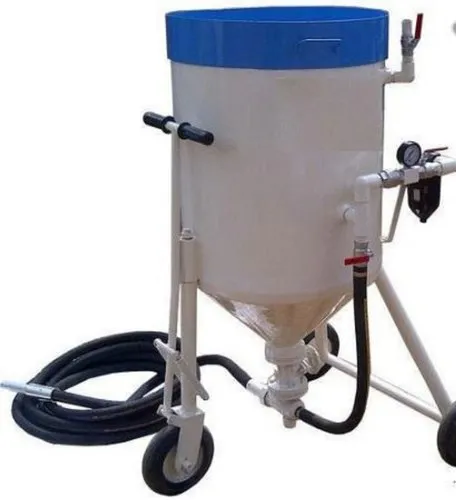
A sand blasting machine, also known as an abrasive blasting machine, is a tool used to propel abrasive particles at high speeds to clean, etch, or prepare surfaces. The abrasive particles can be made from various materials, including sand, aluminum oxide, steel shots, and glass beads. Sand blasting machine come in various sizes and designs, ranging from handheld guns to large cabinets or rooms that can accommodate large objects.
Using Sand Blasting Machine
Using a sand blasting machine can seem intimidating at first, but with proper training and practice, it can become a straightforward process. In this article, we will discuss how to use a sand blasting machine step-by-step to ensure safe and effective use.
Step 1: Wear protective gear
Before using a sand blasting machine, it is essential to wear protective gear to protect yourself from debris and dust. This gear should include a respirator or mask, safety goggles, and gloves. Long sleeves and pants are also recommended to cover exposed skin.
Step 2: Prepare the work area
The next step is to prepare the work area. Make sure the area is well-ventilated and free of flammable materials. Cover any surfaces that you do not want to be blasted with a tarp or plastic sheeting.
Step 3: Load the abrasive material
The abrasive material is the substance that will be propelled by the sand blasting machine to clean or etch the surface. The type of abrasive material used will depend on the application, but common materials include sand, glass beads, aluminum oxide, and steel shot. Load the abrasive material into the hopper of the machine.
Step 4: Adjust the pressure and flow
Adjust the pressure and flow of the sand blasting machine according to the type of surface and the desired finish. Higher pressure and flow rates will remove more material, while lower pressure and flow rates will provide a smoother finish. Consult the machine’s manual for specific instructions on adjusting the pressure and flow.
Step 5: Test the machine
Before starting the actual work, it is essential to test the machine on a small area to ensure that it is functioning correctly and the pressure and flow are appropriate for the surface. Adjust the settings as needed until you achieve the desired result.
Step 6: Begin blasting
Once you have tested the machine and are satisfied with the settings, it is time to begin blasting. Hold the sand blasting gun at a 45-degree angle to the surface, and maintain a consistent distance from the surface to ensure an even finish. Move the gun back and forth over the surface, making sure to cover the entire area. Keep the gun moving to prevent any uneven spots or damage to the surface.
Step 7: Monitor the machine and adjust as needed
During the sand blasting process, it is important to monitor the machine and the abrasive material. If the material is running low, add more to the hopper. If the machine starts to malfunction or the pressure and flow are not consistent, stop immediately and adjust the settings or seek professional help.
Step 8: Clean up
Once the sand blasting cabinet process is complete, turn off the machine and allow it to cool down. Clean up any debris or dust left on the surface and in the work area. Dispose of the used abrasive material properly and store the machine in a safe place.
In conclusion, using a sand blasting machine can be a safe and effective way to clean and prepare surfaces for a variety of applications. By following these steps and taking proper safety precautions, you can achieve the desired result while minimizing the risk of injury or damage to the surface or machine.
What is sand blasting Machine?
sand blasting machine are used for a wide range of applications, including surface preparation, cleaning, and finishing. They are commonly used in industries such as automotive, construction, aerospace, and marine, as well as for home improvement and DIY projects.
The basic components of a sand blasting machine include a sand blasting gun, sand blasting hose, an abrasive material container or hopper, and an air compressor or other pressurization system. The sand blasting gun is typically held by the operator and is used to direct the abrasive material towards the surface being treated.
The sand blasting hose connects the gun to the hopper or abrasive material container, which is typically pressurized to force the abrasive material through the hose and gun. The air compressor or other pressurization system provides the necessary pressure to propel the abrasive particles at high speeds.
Sand blasting machine offer many benefits, including improved surface adhesion, cost-effectiveness, versatility, eco-friendliness, and fast and efficient cleaning. However, it is important to take safety precautions and perform regular maintenance to ensure the longevity and efficiency of the machine.
